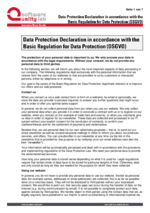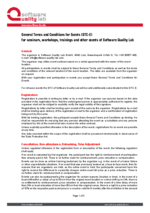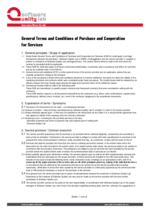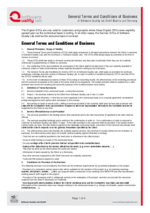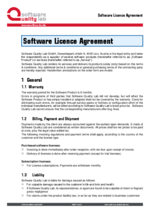General Information
Flyer
-
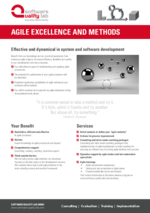 Agile excellence and methods Benefit from our knowledge and our practical experience from numerous agile projects. Increase efficiency, flexibility and quality in your development and test processes.
Agile excellence and methods Benefit from our knowledge and our practical experience from numerous agile projects. Increase efficiency, flexibility and quality in your development and test processes. -
 Architecture analysis These symptons are well known: The older a software system gets, the longer it takes to implement changes to it. This not only stresses developers, but also the customer’s wallet. Architecture analysis adresses methods for uncovering problems and letting software developers go against it efficiently.
Architecture analysis These symptons are well known: The older a software system gets, the longer it takes to implement changes to it. This not only stresses developers, but also the customer’s wallet. Architecture analysis adresses methods for uncovering problems and letting software developers go against it efficiently. -
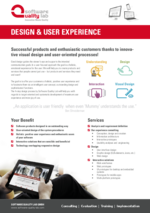 Design & User experience Good design guides the viewer’s eye and supports the intended communication goals. In a user-focused approach the goal is a holistic, emotional experience for the user. We will help you to create products and services that people cannot just use – but products and services they need and want!
Design & User experience Good design guides the viewer’s eye and supports the intended communication goals. In a user-focused approach the goal is a holistic, emotional experience for the user. We will help you to create products and services that people cannot just use – but products and services they need and want! -
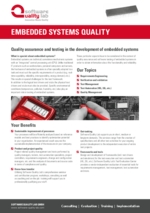 Embedded systems quality What is special about embedded systems? Embedded systems are technical, some times mechatronic systems with an "in tegrated" central processing unit (CPU). Unlike traditional IT products such as workstations, personal computers and servers, the hardware of embedded systems is often specially adapted to a task and must suit the specific requirements of a product.
Embedded systems quality What is special about embedded systems? Embedded systems are technical, some times mechatronic systems with an "in tegrated" central processing unit (CPU). Unlike traditional IT products such as workstations, personal computers and servers, the hardware of embedded systems is often specially adapted to a task and must suit the specific requirements of a product. -
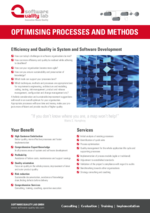 Optimising processes and methods How can today’s challenges in software organisations be met? How can more efficiency and quality be realised while adhering to deadlines? How can your organisation become more agile? How can you ensure sustainability and preservation of knowledge?
Optimising processes and methods How can today’s challenges in software organisations be met? How can more efficiency and quality be realised while adhering to deadlines? How can your organisation become more agile? How can you ensure sustainability and preservation of knowledge? -
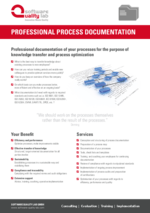 Professional process documentation What is the best way to transfer knowledge aboutexisting processes to new employees? How can you reduce training periods and enable new colleagues to provide optimum services more quickly? How do you keep an overview of how the company really works?
Professional process documentation What is the best way to transfer knowledge aboutexisting processes to new employees? How can you reduce training periods and enable new colleagues to provide optimum services more quickly? How do you keep an overview of how the company really works? -
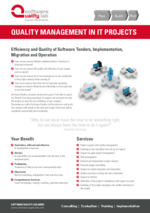 Quality management in IT projects How can you ensure efficient implementation of standard or individual software? How can you ensure the quality and efficiency of your project and its results? How can you ensure not to be massively out in your estimation of the project already when starting it?
Quality management in IT projects How can you ensure efficient implementation of standard or individual software? How can you ensure the quality and efficiency of your project and its results? How can you ensure not to be massively out in your estimation of the project already when starting it? -
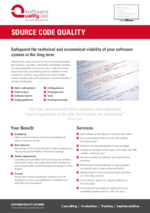 Source code quality Primarily code quality is focused on non-functional requirements like modularity, reusability, analysability, modifiability, testability and comprehensibility of the source code as well as on formal require-ments like programming style and compliance of best practices (i.e. patterns, style guides). Due to more complex software systems code quality represents a fundamental pillar of software development.
Source code quality Primarily code quality is focused on non-functional requirements like modularity, reusability, analysability, modifiability, testability and comprehensibility of the source code as well as on formal require-ments like programming style and compliance of best practices (i.e. patterns, style guides). Due to more complex software systems code quality represents a fundamental pillar of software development. -
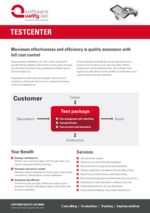 Testcenter Testing becomes calculable for you. Don't burden yourself with yourself with the complexity, risk and effort in the quality assurance and place this in the hands of the professional TestCenter team of Software Quality Lab.
Testcenter Testing becomes calculable for you. Don't burden yourself with yourself with the complexity, risk and effort in the quality assurance and place this in the hands of the professional TestCenter team of Software Quality Lab.
Success Stories
-
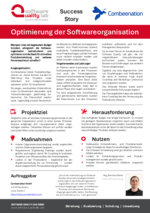 Optimierung der SW-Entwicklung bei Combeenation Wie kann man mit begrenztem Budget trotzdem erfolgreich die Softwareorganisation restrukturieren und optimieren und die Basis für schnellere Produktentwicklung und weiteres Firmenwachstum schaffen?
Optimierung der SW-Entwicklung bei Combeenation Wie kann man mit begrenztem Budget trotzdem erfolgreich die Softwareorganisation restrukturieren und optimieren und die Basis für schnellere Produktentwicklung und weiteres Firmenwachstum schaffen? -
 Agile Transformation der Entwicklungsorganisation bei Industrie Informatik Die komplette Transformation einer jahrzehntelang etablierten Software-Entwicklungsorganisation ist ein herausforderndes und auch unternehmenskritisches Vorhaben. In dieser Success-Story zeigen wir, wie es durch gute Planung und großes Engagement erfolgreich durchgeführt werden kann.
Agile Transformation der Entwicklungsorganisation bei Industrie Informatik Die komplette Transformation einer jahrzehntelang etablierten Software-Entwicklungsorganisation ist ein herausforderndes und auch unternehmenskritisches Vorhaben. In dieser Success-Story zeigen wir, wie es durch gute Planung und großes Engagement erfolgreich durchgeführt werden kann.






